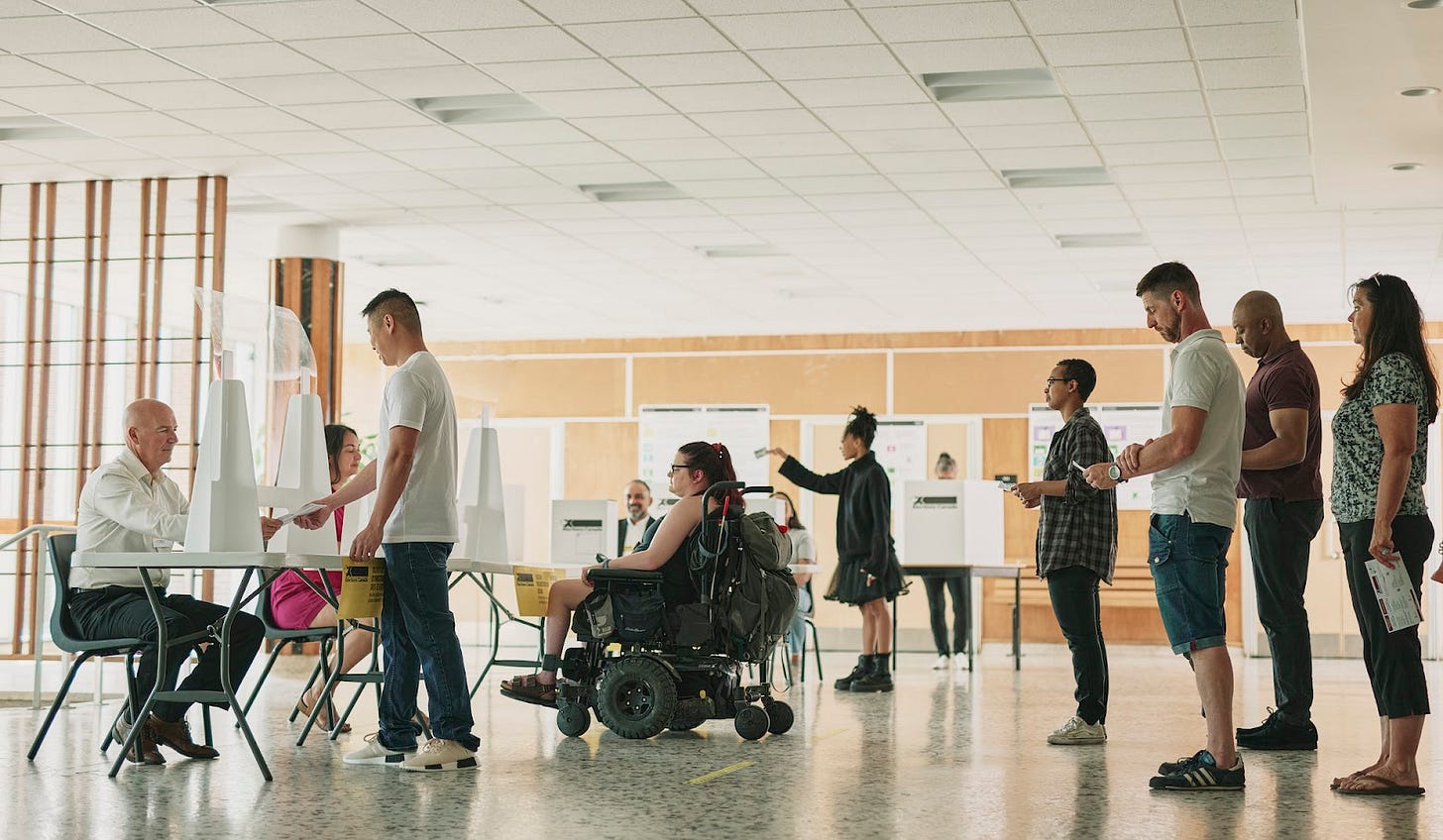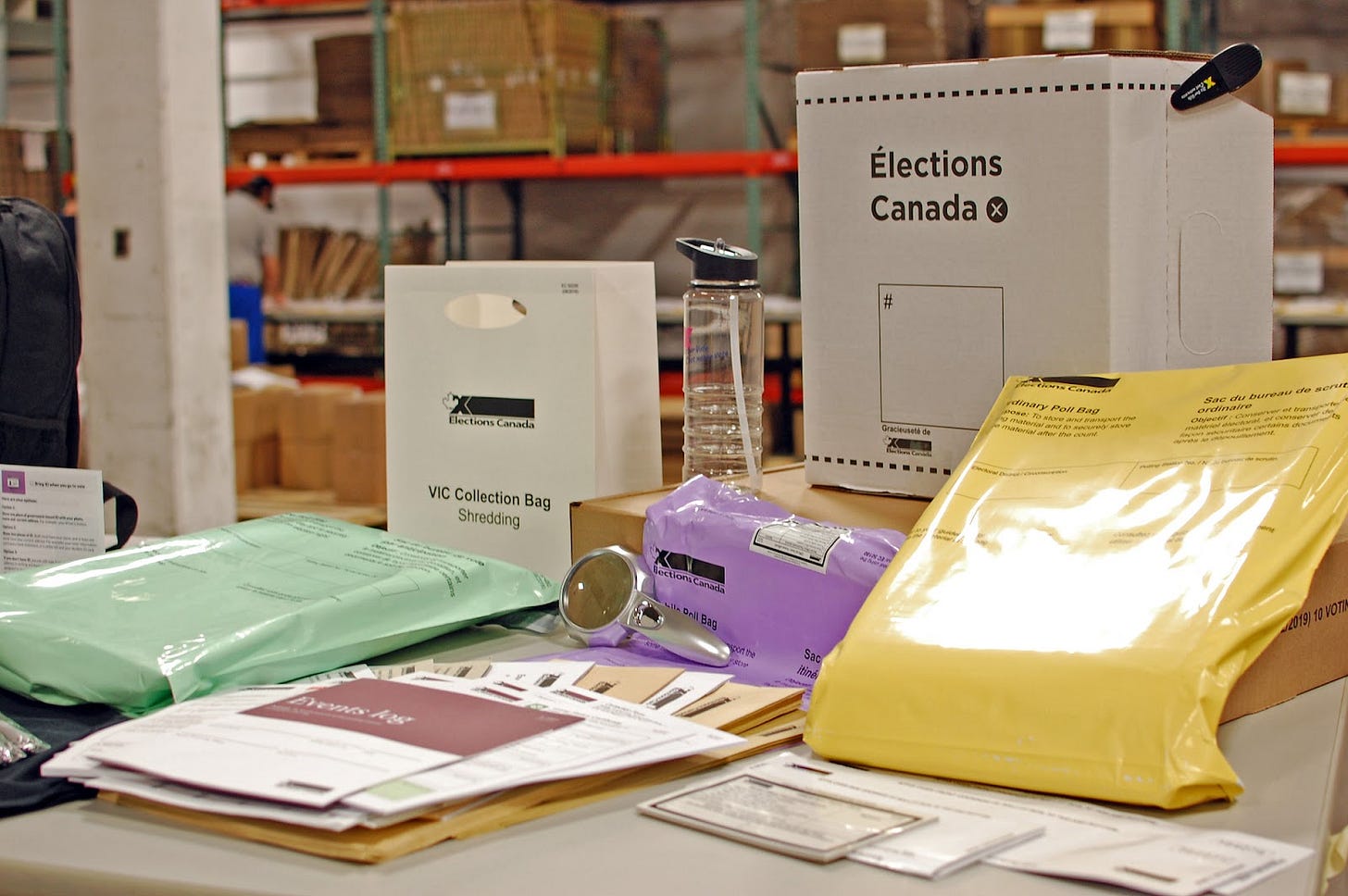Working the Federal Election
Three community members share an insider’s look into the electoral process
If you’ve never worked an election, it may seem to be a smooth and simple process. Elections Canada works hard to make it seem that way. This is an insider’s perspective by three people who worked in the recent federal election.
The terminology can be different between municipal, provincial, and federal systems. In this article, we’ll use federal terms but relate them to the other orders of government.
The Basics
Anyone can apply online and through the returning office for your electoral division or constituency.
Poll workers must be Canadian citizens and can apply up to election day. They can work during the advance voting period and/or on election day, based on interest or level of election experience. Workers are not allowed to leave the polling site until the polls close and, on election day, until ballots have been counted.
Each worker goes through at least one three-hour supervised training session prior to the election and receives training materials to review and take to the polling site according to the role they were hired for..
The Information Officer (IO) helps to set up and close the polling site. They greet and support electors, check that they have IDs and registrations, and direct them to their polling stations. The IO can also assist in the final ballot count.
Registration Officers (RO) set up the registration desk and help prepare the polling site. They help register new electors or direct them to their proper polling site. They handle special registration processes for voters not on the list or not carrying a valid ID. Registration officers can assist in the final ballot count.
Deputy Returning Officers (DROs) ensure you are properly registered and account for newly registered voters. After giving you a ballot and instructions on how to properly fill it out, they direct you to the proper booth. When you return, they make sure your folded ballot is put in the box by you alone. They can manage the custody of the ballots and ballot boxes during the advance vote period and return to count their ballots on election night if they are not working as a DRO on election day. They are responsible for the final ballot count with the assistance of another worker.
The Central Poll Supervisor (CPS) manages the polling site and ensures it runs as efficiently as possible. They are the main contact with the returning office and make sure procedures are being followed and paperwork is completed correctly. When the polls close, a CPS supervises the counting of the ballots, collects the ballot boxes and election materials and transports all the material to the returning office.
Candidates’ representatives, provincially known as Scrutineers, observe the election proceedings and provide the level of scrutiny necessary for a fair and transparent voting process. They are allowed at any poll station and can examine any part of the process.
My Experience as a Deputy Returning Officer - Derek Quittenton
The recent federal election was my fourth or fifth election working as a DRO. It was the end of night when the fun began! The ballot box was dumped on the table and carefully examined to make sure no votes were stuck inside the folds of the cardboard box before the count began.
The suggested counting method where each ballot is examined by two persons and then a tick mark is placed beside the candidate's name is inefficient, especially when pressed for time. At my table, the ballots were simply sorted — a pile of ballots for each candidate. Ballots marked "none of the above" are considered rejected ballots and set aside, there were several at our polling station this election.
The counting began with the smallest pile first and we proceeded pile to pile, carefully counting each ballot. Then every station is issued several ballot books, where each and every book and ballot is counted. And counted again! The ballots marked versus the ballots issued have to add up — if they don't, the recounting would have to start again.
My poll count was one ballot too many and the station beside me was also one ballot short. We realized one voter had put his ballot into the other station's ballot box! This is the kind of mistake that creates extra paperwork and balancing. After reports were filed in triplicate, and signed in triplicate, it was time to close.
That's the numbers story, but the real story is watching the joy in an adult's face as they get to cast their first vote as a Canadian citizen. Voting in a free, fair, and honest election is why these people came to Canada. They want a democracy that is honest and free, and this little piece of paper is huge to first-time voters. You see it in their faces, the tears in their eyes, they are overjoyed to cast their first ballot. You almost wish you could let them keep their ballot as a souvenir.
Get out and vote! Enjoy your democracy. Cherish your right to vote. We are the envy of the world.
An Unprecedented Voting Period - Bronwen Thompson
As a Central Poll Supervisor (CPS) in Edmonton Griesbach, I knew this election would be different from other elections with interest in advance voting at an all-time high. I was ready to jump in and help. Across the country, two million people voted on the first day and, by the end of the advance voting, 7.3 million people (a full quarter of registered electors) had voted!
I also worked as a CPS during election day. It started at 6:30 in the morning and stretched until the counting of ballots was complete. When I opened the door to check the line at 7:30 I was greeted by Jasper, the neighbourhood cat, determined to come into the school gym as my first voter. I was asked if a pawprint was deemed acceptable on the ballot, but I responded with a laugh that he couldn't vote because he hadn't brought his voter identification card.
Election day for us ran much smoother than the advance voting, with so many electors that I had to call the returning office for more ballots shortly after noon. Once the polls closed at 7:30 pm, the DROs sealed the ballot boxes and made sure that their paperwork was balanced.
On hand were the candidates' representatives to watch the final count and dispute any decisions regarding questionable ballots. Once all the polling stations had completed their count, the CPSs completed their final paperwork and everything was gathered and transported in my car to the returning office.
Eighteen hours after I left, I returned home to a very unhappy cat and I spent the next day lying on the couch because I could barely walk. I didn't mind because I had recorded all the CBC election night coverage, from the polls closing in Newfoundland all the way to Mark Carney's acceptance speech, which I watched from beginning to end. Yes, I'm a political junkie.
My First Election as a Poll Worker - Sherridon Routley
Being late to work the election, my training as a standby was a brief three-hour session the day before the event. We had no knowledge of what role we’d be assigned, so we received a stack of manuals covering all positions to review that night. Admittedly, I only partially skimmed these as there were scant hours to sleep before the big day.
Arriving early to the local returning office, we learned that all of us were needed to fill absent roles. I was the only one volunteering to be a DRO, so I was assigned a station and off I went on my bike. My polling centre happened to be on the north side of the Victoria School of Arts and preparation was in full swing for the doors at 7:30 am.
I was surprised that some stations received as few as four electors whereas my station was the busiest in the centre! A few people requested pen instead of pencil and they were happily facilitated. I prefer pens, but Elections Canada says it supplies pencils because they don’t leak or dry up and spoil a good ballot. You only get two chances to get the ballot right.
The only real snag during the day was when the Elections Canada website went down and the services to quickly help unregistered voters weren’t available. This caused the largest lineup of the day at the registration table, but it was dealt with as quickly as possible with the worst wait being 30 minutes.
My favourite part of the day was that no workers could discuss politics, and we extended that restriction to all politics. We agreed that avoiding the neverending churn of opinions and divisions in our world for at least one day was a state of bliss.
The real work came when the polls closed and the count began. There was an ‘observer’, who oversaw the integrity of the process, and one of the Information Officers to help me count. I appreciated the IO’s help to slog through what could have been an overwhelming process if the count did not add up properly… but it did!
The hardest part was closing the station to the strict rules of Elections Canada in as little time as possible. How my tired brain managed to power through the lengthy instructions, I have no idea. Once again, my IO came to the rescue, helping me follow the manual quickly. I learned the many processes in place to make sure the polls collected were accurate and honest.
You can get more interesting insights into the electoral process at the Election Canada website.
Article credits shared by Derek Quittenton, Bronwen Thompson and Sherridon Routley with editing by Sherridon Routley.











